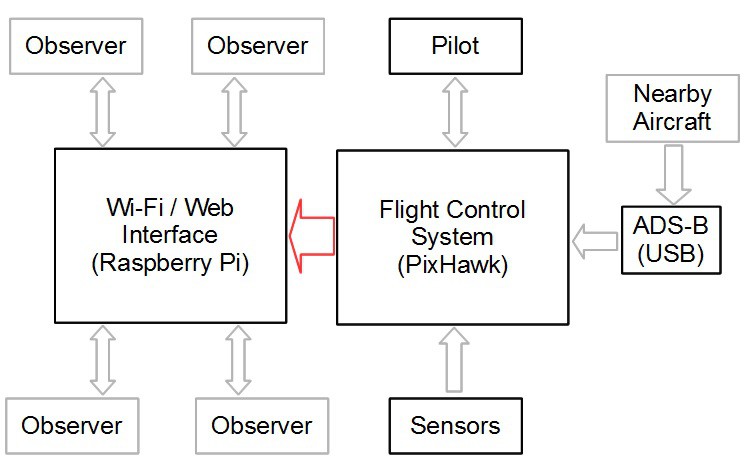One thing I hadn't addressed yet in the project logs is the connectivity requirement of The Hackaday Prize. I've had some concepts that I want to incorporate into Goliath, and over the past few weeks I've had a chance to refine some of those ideas.
There are a lot of discussions about the pros and cons of drones. The safety of others, is one of the concerns that people have, either due to a drone hitting a person or colliding with an aircraft. How do we address this valid concern? While Goliath is bigger and the consequences of a collision could be more serious, it does have the advantage that it has the ability to carry more hardware than a typical drone.
The FAA has addressed the potential for mid-air collisions with ADS-B. Using this system, individual aircraft transmits a standard signal to nearby aircraft with location and airspeed data. While the system is intended to be 2-way (I don't think the FAA wants Goliath broadcasting the signal), the system can be used in a 1-way mode to locate other aircraft. John Wiseman (@lemonoder) has a great page on his blog on adding Cheap ADS-B on amateur drones. He got the information on Hacking a $20 USB TV Tuner to receive the ADS-B data from Clayton Smith. This could be integrated into the PixHawk to notify the Pilot of nearby aircraft and help prevent collisions. Not all aircraft are equipped yet, but having this capability on Goliath would help. All aircraft are supposed to be equipped with ADS-B by 2020.
So what if we could have something similar to ADS-B for people and drones? Almost everyone has a smart phone these days. What if Goliath was equipped so that people could interface with it and provide their location data? What if they wanted to know more about Goliath? What if they really don't want it around?
To address this Goliath is going to be equipped with a Raspberry Pi setup up as a Wireless access point. An observer notices Goliath and sees that there is a new network available (say DRONE-FEEDBACK or something like that). The connect to it and it brings up a webpage that provides information about Goliath. The page would allow the user to share their location with Goliath (if they desire) to help maintain safe distances, submit feedback data to the operator and maybe even access some of the data from Goliath. The Raspberry Pi would be connected to the PixHawk to receive some of it's data, but hopefully in a manner that prevents someone from maliciously accessing the PixHawk directly. See diagram below:

For The Hackaday Prize, the emphasis would be on the Wi-Fi / Web Interface and if time allows the ADS-B would be incorporated. This is because it's unlikely Goliath will be operating near other aircraft anytime soon.
Meanwhile I've been working with the CNC router and had two hacks I wanted to post. The first was to address the amount of foam shavings that get everywhere. The CNC router has had a dust collection system for sometime, and the end of the 4" ducting was brought up to the router, but nothing was done to route the vacuum closer to the spindle. This week I made a shroud out of cardboard that seems to be working well.


The other hack I did this week was to address the CNC hardware resetting in the the middle of cutting. After doing some research, the culprit was likely the Gecko G540 overheating. There is some good documentation on adding heat sinks and/or fans to improve the heat rejection. I stopped by the local electronics store and got some heat sinks. However no one seems to carry the thermal adhesive locally. So in the mean time I used some zip ties to attach the heat sinks. It seems to be working because I haven't had an issues since.

 Peter McCloud
Peter McCloud
Discussions
Become a Hackaday.io Member
Create an account to leave a comment. Already have an account? Log In.